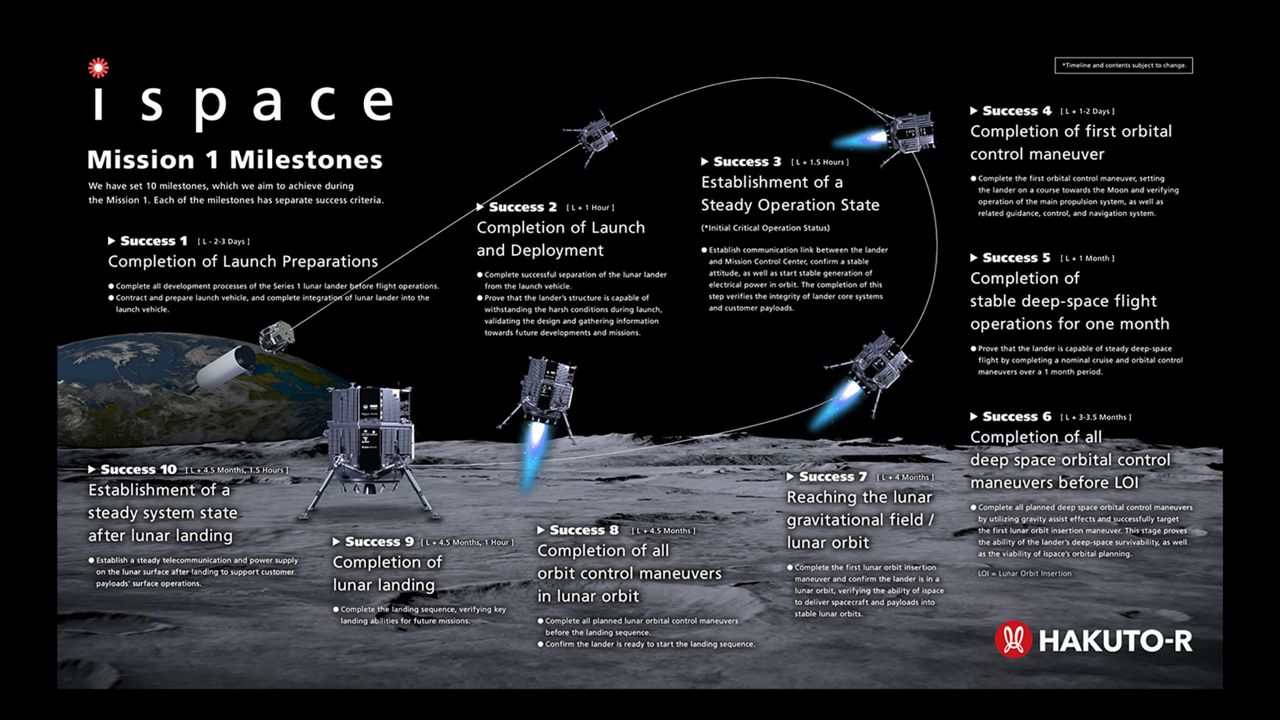ORLANDO, Fla. — Japanese company ispace says it failed to successfully land its HAKUTO-R lunar craft landed on the Moon on Tuesday afternoon.
What You Need To Know
- The HAKUTO-R lunar lander spent the last 5 months traveling to the moon
- ispace launched its first lunar mission atop a SpaceX Falcon 9 rocket from Cape Canaveral Space Force Station in December
- The lander is carrying several payloads, including the first lunar rover for the UAE
- RELATED coverage: Japan-based ispace aims to put the first privately-funded lander on the moon
- 🔻Scroll down to watch the launch🔻
In an update Tuesday evening on the East Coast (Wednesday morning in Tokyo), the company said as the lander made its final approach to the surface, data showed it was getting low on propellant. It then started to quickly speed its descent towards the Moon before the signal was lost.
During the live broadcast of the landing attempt, ispace founder and CEO Takeshi Hakamada confirmed that their engineers couldn’t establish communications with the lander and as they were investigating what happened.
"We have to assume that ... we could not complete the landing on the lunar surface," Hakamada said. "Our engineers will continue to investigate the situation and we will update you with further information once we finished the investigation."
He said that communications were lost at the very moment of when the craft was supposed to touchdown on the moon's surface, meaning that before that moment, the company's engineers have flight data to review.
"At this moment, what I can tell is we are very proud of the fact we have already achieved many things in this mission one," he said, such as the flight data his team has access to.
That information will be used for missions two and three, he said.
In a statement released by ispace, Hiroshi Yamakawa, The Japanese Aerospace Exploration Agency (JAXA), the agency which had transformable robot aboard the lander, offered words of support.
“As a fellow Japanese space enthusiast, I am proud of ispace’s challenge and respect the efforts of everyone involved. ispace will analyze the data obtained from this mission and use it as a foundation for the next mission,” Yamakawa said. “JAXA will continue to make steady progress together with ispace, the industry and organizations challenging space, and our international partners, and will contribute not only to space exploration activities but also to the sustainable development of human society.”
Meeting the HAKUTO-R lunar lander
The HAKUTO-R lunar lander launched aboard a SpaceX Falcon 9 rocket from Cape Canaveral Space Force Station in Florida back in mid-December 2022 and has been coasting toward the moon in the months since. This is the first mission for ispace, which was founded in 2010.
In the run-up to launch, ispace founder and CEO Takeshi Hakamada spoke with Spectrum News about the excitement of this opportunity.
“I’m very excited for this moment and my team as well. It’s a very surreal moment opening the door for the new commercial industry in this area,” Hakamada said. “And we are very proud we are going to be the first to land on the moon as a private company.”
The lander carries with it a host of payloads, including a small rover from the United Arab Emirates and a transforming robot from the Japanese Aerospace Exploration Agency (JAXA).
Unlike future Artemis human missions heading to the moon’s south pole, the ispace mission is set to touch down on the northern end of the moon in an area called the “Atlas Crater.”
The primary landing site for our HAKUTO-R Mission 1 is Atlas Crater, located in the northeastern quadrant of the Moon. (1/3)
— ispace (@ispace_inc) April 25, 2023
📸 @NASA #ispace #HAKUTO_R #lunarquest pic.twitter.com/qmomqdg17J
Back in 2019, the Israeli organization SpaceIL and the Israeli Space Agency tried to land the first private lander on the moon but failed. ispace is hoping to successfully deliver its lander with a soft touchdown to begin a suite of research.
There were 10 mission milestones that ispace laid out as its roadmap to a successful mission. Because engineers determined that the propellant levels were too low during the final descent, they were only able to move through mission milestone 8.
ispace said it will evaluate the data from the Mission 1 landing attempt and make needed adjustments before their Mission 2 launch, planned for 2024.




